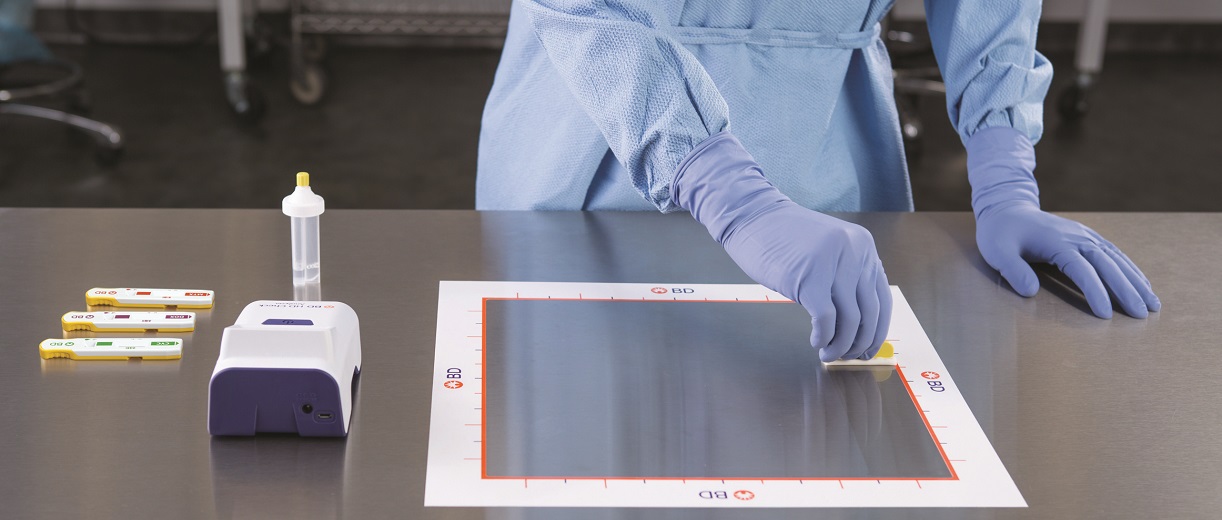Scientific publication: Analysis of chemical contamination by hazardous drugs with BD® HD Check System in a tertiary hospital
Valero García S., Centelles‐Oria M., Palanques‐Pastor T., Vila Clérigues, N., López‐Briz E. and Poveda Andrés J. L., 2021. Journal of Oncology Pharmacy Practice. DOI: 10.1177/10781552211038518
A hazardous drug (HD) is defined as a drug that displays one or more of the following six characteristics: carcinogenicity, teratogenicity or other developmental toxicity, reproductive toxicity, organ toxicity at low doses, genotoxicity or a structure or toxicity profile that mimics an existing HD.1 In the hospital setting, the transdermal route is considered the main route of exposure to HD. Therefore, studies and guidelines recommend surface monitoring for risk assessment of healthcare professionals’ exposure.1
Establishing a direct relationship between exposure and the development of adverse effects is difficult due to the multifactorial nature of these types of pathological processes. Thus, a precautional approach based on the As Low As Reasonably Achievable (ALARA) principle should be utilized.1 The availability of detection techniques is critical for successfully carrying out monitoring for HD surface contamination.
The BD® HD Check System is a semi-quantitative device that detects surface HD drug contamination, providing a baseline reading within 10 minutes of sample collection.1, 2, 3 The use of new, semi-quantitative techniques, that are cheaper and require less time to obtain results, may increase the sampling frequency.1
Study methodology
This scientific publication in the Journal of Oncology Pharmacy Practice has resulted from a study conducted by researchers at the Instituto de Investigación Sanitaria La Fe and the Hospital Universitari i Politècnic La Fe, Spain. It is a prospective, observational and cross-sectional study that was carried out in a tertiary hospital during the months of August-September 2020.
The primary objective of this study was to determine the existence of HD on the work surfaces where these types of drugs are handled in different locations of a tertiary hospital, using the BD HD Check® semi-quantitative device.
The risks for exposure to HD are not confined to the pharmacy, where high-level monitoring and protective measures were already being implemented.1 So, different locations were selected in various admission units, outpatient clinics, pharmacy departments, and day hospitals, based on the usage of HDs during the six months before the start of the study. The sampling was performed at the end of the morning workday over several days and before cleaning to identify the highest potential degree of contamination to which healthcare workers could be exposed.
Results
A total of 251 samples were analyzed: 80 locations in 10 clinical units were tested for methotrexate (MTX), 89 locations in 13 clinical units for doxorubicin (DOX) and 82 locations in 11 clinical units for cyclophosphamide (CYC). The percentage of surfaces with the presence of at least one HD was 13.1%.
The percentage of samples found to be positive in different locations tested has shown the following results.
Methotrexate was found in:
- 100% of the samples from the treatment dispensing cart
- 85.7% of the samples in the pediatric oncology and pediatric transplant admissions
- 80% of the samples in the adult hematology admission
- 60% of the samples in the adult oncology admission
- 50% of the samples in the intensive care
- 16.7% of the samples in the aseptic pharmacy
- 11% of the samples in the adult miscellaneous and haematology day hospital
Cyclophosphamide was found in:
- 25% of the samples in the urology admission
- 20% of the samples in the aseptic pharmacy
Doxorubicin was not detected in any of the samples collected.
Conclusion
This study is the first to use a semi‐quantitative technique for the detection of HD on surfaces.1
Even though the technology does not allow precise quantification of the amount of HD present, the actions to be taken upon the detection of contamination are not different than when using a traditional liquid chromatography/mass spectrometric analysis of the samples.
The principal advantages of a semi‐quantitative technique have been:
- Speed and immediacy in obtaining results, allowing immediate corrective measures when positive results were detected
- A quick assessment of the effectiveness of the containment and control measures
References
1 Valero García S., Centelles‐Oria M., Palanques‐Pastor T., et.al, 2021. Analysis of chemical contamination by hazardous drugs with BD HD Check® system in a tertiary hospital. Journal of Oncology Pharmacy Practice. DOI: 10.1177/10781552211038518
2 BD HD Check System QRG 10000292556 02 (v0.2) – Quick Reference Guide..
3 https://www.bd.com/en-us/company/video-gallery?video=6186780128001 BD® HD Check instructional in-service video
The references to third-party peer-reviewed material and the sites they are hosted on are provided for your reference and convenience only, and do not imply any review or endorsement of the material or any association with their operators. The Third-Party References (and the websites to which they link) may contain information that is inaccurate, incomplete, or outdated. Your access and use of the Third Party Sites (and any websites to which they link) is solely at your own risk.
BD-47983




